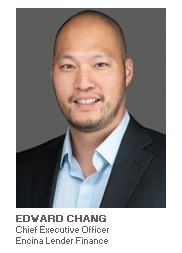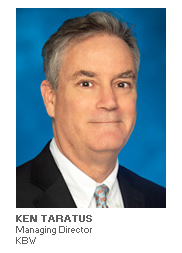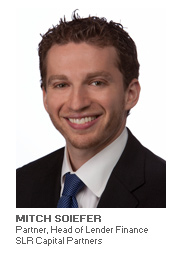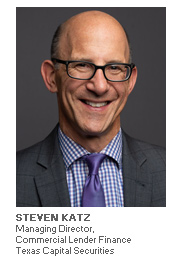
In this second installment of a quarterly ABL Advisor article series, Charlie Perer meets with commercial finance industry professionals to discuss the state of the lender finance industry and general market dynamics. The objective of this series is to engage with a panel of industry leaders specializing in lender finance, with the aim of gaining insights into their perspectives on the market and understanding their strategic business positioning.
Here to tell the story are Edward Chang, Chief Executive Officer of Encina Lender Finance, Steven Katz, Managing Director, Commercial Lender Finance with Texas Capital Securities, Kenneth Taratus, Managing Director of Keefe, Bruyette & Woods and Mitch Soiefer, Partner, Head of Lender Finance with SLR Capital Partners.
Charlie Perer: To begin, please briefly introduce yourselves.
Ken Taratus: I am the head of private debt placements at Keefe, Bruyette and Woods (“KBW”) where I work with both balance sheet lenders and balance sheet light companies in the financial services and fintech sectors.
Ed Chang: I am the CEO of Encina Lender Finance (ELF). Under our commercial vertical, ELF lends to ABL, factoring and equipment finance companies. ELF also lends to consumer finance companies across a broad spectrum of asset classes including credit cards, installment loans and secured vehicle financing.
Mitch Soiefer: I am the head of Lender Finance at SLR Capital Partners and am in my fifteenth year with the SLR Platform. We provide both debt and equity investments to commercial finance companies.
Steven Katz: I am head of the Commercial Lender Finance business at Texas Capital, a group that was started about 4 years ago to complement the firm’s existing Consumer Lender Finance business, which has been an active group for 20 years. I have been involved in specialty finance my entire career which includes working within investment banking, bond insurance and bond ratings. I have specifically been involved in lender finance for 15 years, starting at Wells Fargo Lender Finance.
Perer: How has the lender finance market evolved since 2008?

Chang: In 2008, the lender finance market did not exist as we know it today. There were very few institutions that specialized in lending to traditional commercial finance companies. Over the last decade, the market has grown exponentially, with a proliferation of entrants across bank and non-bank institutions.
Soiefer: The demand for lender finance capital has grown substantially since 2008. Of note, there has been a continued movement toward direct lenders such as SLR, which has more flexible capital to meet that demand. We are talking to many more mid-size finance companies today than in 2008 as several platforms have launched outside of banks with a focus on specific market niches, and our firm has the expertise to underwrite these niches.
Taratus: In 2008, we were mainly doing lender finance transactions with a few commercial banks such as Wells Fargo, CIT and CapitalSource. Since then, the number of institutions doing lender finance has exploded! Almost every commercial bank has a lender finance group and non-banks have entered the market in a big way. Non-banks also have a much bigger hold position than commercial banks. While most commercial banks will need to syndicate any deal over $75 million and typically like to start smaller, we have seen the non-banks putting in place and holding much larger positions. We recently increased a revolving credit facility to $400 million with one non-bank and they are holding the entire position.
Katz: I started my lender finance career at Wells Fargo in June 2008 and was thrust into an opportunity where the bank was looking to capitalize on the withdrawal of most other banks given the economic downturn. I underwrote numerous deals during that time and really learned the business. In the 15 years that I’ve been involved in the industry, we have seen the emergence of other lender types, giving companies in need of capital other options to choose from, such as MCAs. Also, as technology continues to evolve, fintechs emerged as capital providers, basically building a better mousetrap to help access funds in a faster and easier manner.
Perer: What does today’s market look like in terms of banks and non-banks and their appetites for different asset classes?
Chang: Banks are in another cycle of credit tightening. Traditional commercial finance companies may still find receptivity at banks, albeit at a higher bar and cost, and with significant value placed on deposits, treasury revenue and other bank products. Many banks are “sitting out” this part of the cycle. This has allowed non-bank shops to go deeper and wider into lender finance asset classes.

Taratus: Most commercial banks have retreated to the traditional asset classes they know best, such as factoring and equipment leasing or will provide first-out revolvers at low advance rates where non-banks provide the rest of the leverage. We have not seen them aggressively go after other asset classes such as merchant cash advance, debt buyers or consumer. We have also seen banks focusing on relationships where they can hold deposits or get additional revenue streams that do not require capital, such as treasury management services. The non-banks will look at everything and can be much more flexible in their structuring by offering unitranche facilities, second lien options or deferring a portion of the payments through paid-in-kind interest or warrants.
Soiefer: Increasingly, we have seen more participation from non-banks as some banks, especially the regionals, have pulled back from the market. At this point in the economic cycle, with so much uncertainty, there is definitely a flight to quality. Companies with established track records in asset classes that have performed through previous cycles are still able to obtain flexible financing solutions.
Katz: For Texas Capital, the appetite to grow assets in our core business of financing asset-based lenders, factors and equipment finance companies has not changed despite the changing economy and rising interest rates. There is more scrutiny, for example, to make sure there is more than adequate capital to protect against losses, and borrowers are not chasing bad deals for growth’s sake.
Perer: What void is the non-bank lender finance world filling?
Taratus: The non-bank lenders fill the void in two main ways. First, they will look at any asset class. Second, they typically offer a higher advance rate, higher cost option to borrowers. As an example, we recently ran a process where we received bids from (i) commercial banks at a 65% advance rate at a cost of S+325 and (ii) non-banks at an 85% advance rate at a cost of S+525-600. While the overall rate was higher, the borrower chose a non-bank lender because the weighted average cost of capital (WACC) was lower due to the lower amount of equity needed. In addition, some of the credit funds can provide larger facilities that do not require dealing with multiple lenders but can also grow with their borrowers. Traditionally, the typical take out for credit funds was bank funding, while today some of the credit funds have insurance company affiliates that can offer cheaper term loan debt which allows them to keep the credits longer.
Chang: As banks tighten credit boxes and offer a “one size fits all” approach, specialty finance companies are seeing decreased access to bank debt. These specialized finance companies may have “stubbed their toe,” need more flexibility than banks can provide or be earlier stage. The non-bank lender finance world provides these companies with fast, flexible, customized and dependable capital solutions to grow their businesses. For example, ELF has hundreds of years of lender finance experience across its team. We’re dedicated to this space (regardless of the cycle), we understand our customers’ needs, and we execute quickly.

Soiefer: Banks will always be a large participant in this market, as their cost of capital will almost always be lower than non-banks. However, non-banks are supporting companies which might either be facing banks that are pulling back or firms that are outgrowing their existing banking relationships.
Perer: How has your firm’s sector or asset appetite shifted over the past year?
Soiefer: At SLR, we have been fortunate to add significant investment capital within the past year. So, while our strategy remains consistent, we have significantly more capital to invest in the sector. In general, we are always looking for commercial finance businesses that can withstand times of economic stress and that remains the same.
Chang: For our commercial vertical, ELF has homed in on ABL, factoring and equipment finance companies. That’s our bread and butter, and it’s what our team has specialized in for the past two decades.

Katz: Texas Capital has not had a shift in asset appetite since our Commercial Lender Finance business’ inception 4 years ago. A big part of our “steady as she goes” approach is aided by the strength of Texas Capital’s balance sheet. The firm is strongly capitalized with ample liquidity, and growth is mandated not only within Lender Finance, but firm wide.
Taratus: We are a placement agent so we really shift with the market and what we think can get done. In terms of asset classes, we are staying away from auto right now due to the recent volatility in auto prices and moving into asset classes such as debt buyers where prices have declined. We are seeing deals getting done in factoring, equipment leasing, merchant cash advance and certain consumer areas. In terms of product, there is always consistent demand for senior debt financing, though we have seen lot more demand for junior capital as valuations have been depressed, which sometimes leads to refinancing of both the senior and junior debt that can produce similar weighted average cost of capital, but most importantly allows our clients to continue growing and originating.
Perer: What types of deals would your firm have bid on a year ago that you no longer need to do today, and vice versa?
Taratus: A year ago, we would have looked at auto deals more than we do today. We also helped borrowers add to their syndicate of banks. We are not doing that today because it seems to be much harder to bring banks into a syndicate unless they get deposits. On the other hand, we are seeing very interesting opportunities in the more exotic asset classes.
Katz: No changes in our go to market approach over the last year regarding types of deals. If we are looking to bring on a new client, we would be looking for primarily the same characteristics regardless of the economic environment. That always starts with the credibility and experience of the management team, and their success during all economic cycles, coupled with suitable and available capital.
Chang: ELF has deemphasized lending to private credit and real estate bridge lending platforms. It’s not because they are “bad” asset classes, but rather ELF is focusing its efforts and resources around a narrower set of asset classes.
Perer: What’s the boots on the ground feedback from the lenders you finance?
Katz: It is tough finding good deals; many of our ABL and factor clients were hoping to see the floodgates open as banks were expected to jettison weaker and smaller deals, as well as pick up deals from bank special asset groups. This has happened to a much lesser extent. I would guess many of the banks are focusing more on commercial real estate in their portfolios at the moment. For our borrowers, thankfully, asset quality is holding up well, which is a strong positive.
Soiefer: Generally speaking, credit quality remains relatively healthy. While there are pockets of the economy that are seeing softness, there are others that are performing well. Access to capital, however, is more challenging than it has been in the past couple of years, and we are looking to help fill this void.
Chang: Business has been good! Our customers are seeing better quality transactions with better economics. With the pull-back and tightening of banks, there is a nice opportunity now for our customers to grow substantially. ELF has been busy upsizing commitments across its portfolio to support customer growth.
Taratus: Both commercial banks and non-banks are more conservative today. For the most part, advance rates have declined 5 to 10 percent across asset classes and interest rates have gone up. Commercial banks have retreated from certain asset classes such as consumer, and lenders that typically compete with banks for their products are seeing an increase in attractive opportunities. The slowdown in the securitization market has caused lenders to hold assets longer so they are not getting as much turnover in their assets as they have seen in the past. Fixed rate lenders are very concerned about their NIM with the recent increases in SOFR and those that cannot adjust rates to their borrowers are having troubles.
Continued on Page 2...